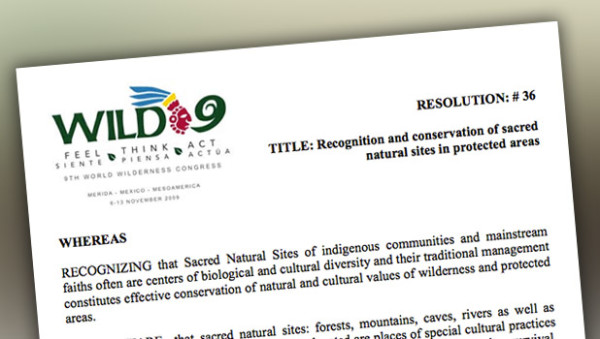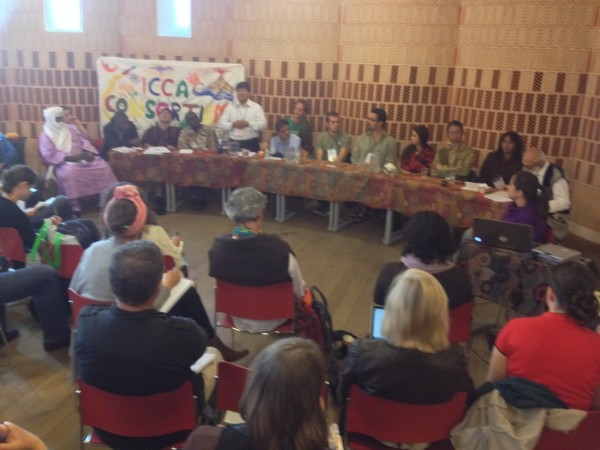
O 10Congreso World World Wilderness viu discusións significativas sobre moitos problemas relacionados con Sitios naturais sagrados e comunidades indíxenas. A iniciativa de sitios naturais sagrados presentada sobre a importancia dos sitios naturais sagrados nas estratexias de conservación das paisaxes espirituais así como das redes mundiais en rutas de montaña. Un dos asesores de SNSI, Líder espiritual maia e coordinador de Oxlajuj Ajpop MR. Felipe Gómez, presentou presentacións e participou no Foro de terras indíxenas e mariñas. Na forma exploráronse varios problemas importantes dos cales destacaron dous. O primeiro número centrouse en como frear as industrias extractivas irresponsables que poñen os sitios naturais sagrados do mundo, Áreas protexidas e sitios do patrimonio mundial en risco, mentres que o segundo número explorou o concepto de deserto visto en diversas vistas ao mundo.

Anteriormente en Wild 9 Esta resolución sobre sitios naturais sagrados en áreas protexidas adoptouse en 2009 (ver a biblioteca). Este ano propuxéronse dúas resolucións adicionais en salvaxe 10 (Siga as ligazóns desta noticia).
A conservación do deserto cruza claramente coa protección e revitalización dos sitios naturais sagrados e as ameazas que lles supuxo as industrias extractivas. Como parte dun grupo máis amplo liderado pola Fundación Gaia e Tilcepa The Sacred Natural Sites Initiative apoiou o desenvolvemento de dúas resolucións. Ambas as resolucións están abertas para vostede Comentario e "Iniciar sesión". O Primeira resolución tratado directamente co establecemento de zonas sen ir para as industrias extractivas sobre os sitios naturais sagrados. Atopou apoio con áreas protexidas e sitios do patrimonio mundial que tamén están a experimentar unha intrusión por parte das industrias extractivas, Especialmente a minería.
O segunda resolución Chama ao recoñecemento de sitios e territorios naturais sagrados como unha categoría distinta da área protexida, respectando que existe unha pluralidade de sistemas de Sitios Naturais Sagrados que deberían ser recoñecidos cada un nos seus propios termos, tal e como expresan as súas comunidades de custodia.; e que esta categoría debería ser recoñecida en foros internacionais (como as convocadas pola UICN) e nos instrumentos e políticas legais, especialmente o Convenio sobre a Diversidade Biolóxica. Con varias resolucións clave xa adoptadas en WILD9 en 2009 e os Congresos Mundiais da Conservación en 2008 e 2012, Espérase que estas resolucións WILD10 engaden peso a cuestións urxentes que agardan o recoñecemento da comunidade internacional.
Ademais do traballo en Lugares Naturais Sagrados, unha sesión acomodada polo Consorcio de Áreas Conservadas Indíxenas e Comunitarias sobre oito representantes indíxenas de diferentes etnias – Will-qui-aht, Maya K'iche, Vou discutir, Son Walku, Yuareg, Pongso no Tao entre outros – deron as súas opinións sobre o verdadeiro significado de Wilderness. Os exemplos dados mostraron a riqueza das cosmovisións que complementan, se non esmagadora, a visión dos conservacionistas sobre a natureza salvaxe..

Os participantes no Foro da Terra e do Mar Indíxenas en Wild 10 discutir o significado do deserto nas súas cosmovisións, así como a importancia dos sitios naturais sagrados protexidos das industrias extractivas e doutros desenvolvementos incontrolados.. Orixe: B. Verschuuren 2013.
Cando will-o-o-qui-aht persoas en Canadá pedíuselles unha palabra para o deserto na súa lingua, retiráronse catro días e finalmente decidiron a palabra "casa" Felipe Gómez do Oxlajuj Ajpop [www.oxlajujajpop.org.gt] salientou que o deserto é parte da nosa nai terra do que todos nacemos. Na espiritualidade de Maya k´iche a terra require escoitar, falando e coidando os seus sitios sagrados de acordo co Calendario maia. Todos os exemplos mostraron unha relación de reciprocidade coa terra, natureza e territorio. Os diversos testemuños sobre a base do deserto don don vistas do mundo indíxenas demostraron que a visión proteccionista exclusiva das terras salvaxes nulo das persoas non ten lugar na conservación do noso mundo común. Tal legado é difícil de superar ou mellorar, pero a marea está a xirar finalmente.
Stan Stevens, O tesoureiro do consorcio ICCA suxeriu que a conservación do deserto tería parecido moi diferente se os seus primeiros fundadores como Aldo Leopold e John Muir terían aprendido máis formar os líderes dos pobos indíxenas do seu tempo. Vance Martin, O director da Wild Foundation recoñeceu a importancia destas visións do mundo en canto a representar unha diversidade de solucións para a conservación. Previu que debería ser posible seguir estas relacións indíxenas coa terra e buscar unha forza unificadora de amor polo deserto e a nai terra que a través da evolución foi codificada nos nosos xenes.






